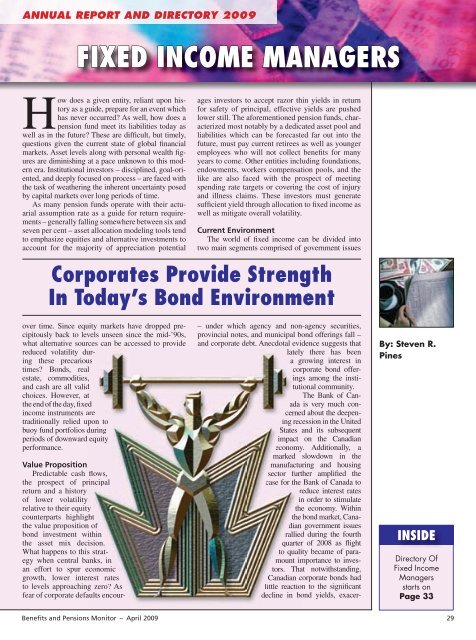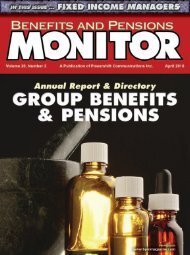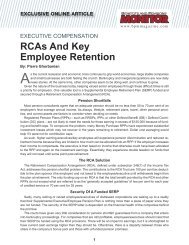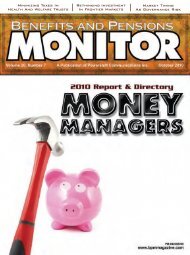April - Benefits and Pensions Monitor
April - Benefits and Pensions Monitor
April - Benefits and Pensions Monitor
Create successful ePaper yourself
Turn your PDF publications into a flip-book with our unique Google optimized e-Paper software.
ANNUAL REPORT AND DIRECTORY 2009<br />
FIXED INCOME MANAGERS<br />
How does a given entity, reliant upon history<br />
as a guide, prepare for an event which<br />
has never occurred? As well, how does a<br />
pension fund meet its liabilities today as<br />
well as in the future? These are difficult, but timely,<br />
questions given the current state of global financial<br />
markets. Asset levels along with personal wealth figures<br />
are diminishing at a pace unknown to this modern<br />
era. Institutional investors – disciplined, goal-oriented,<br />
<strong>and</strong> deeply focused on process – are faced with<br />
the task of weathering the inherent uncertainty posed<br />
by capital markets over long periods of time.<br />
As many pension funds operate with their actuarial<br />
assumption rate as a guide for return requirements<br />
– generally falling somewhere between six <strong>and</strong><br />
seven per cent – asset allocation modeling tools tend<br />
to emphasize equities <strong>and</strong> alternative investments to<br />
account for the majority of appreciation potential<br />
ages investors to accept razor thin yields in return<br />
for safety of principal, effective yields are pushed<br />
lower still. The aforementioned pension funds, characterized<br />
most notably by a dedicated asset pool <strong>and</strong><br />
liabilities which can be forecasted far out into the<br />
future, must pay current retirees as well as younger<br />
employees who will not collect benefits for many<br />
years to come. Other entities including foundations,<br />
endowments, workers compensation pools, <strong>and</strong> the<br />
like are also faced with the prospect of meeting<br />
spending rate targets or covering the cost of injury<br />
<strong>and</strong> illness claims. These investors must generate<br />
sufficient yield through allocation to fixed income as<br />
well as mitigate overall volatility.<br />
Current Environment<br />
The world of fixed income can be divided into<br />
two main segments comprised of government issues<br />
Corporates Provide Strength<br />
In Today’s Bond Environment<br />
over time. Since equity markets have dropped precipitously<br />
back to levels unseen since the mid-’90s,<br />
what alternative sources can be accessed to provide<br />
reduced volatility during<br />
these precarious<br />
times? Bonds, real<br />
estate, commodities,<br />
<strong>and</strong> cash are all valid<br />
choices. However, at<br />
the end of the day, fixed<br />
income instruments are<br />
traditionally relied upon to<br />
buoy fund portfolios during<br />
periods of downward equity<br />
performance.<br />
Value Proposition<br />
Predictable cash flows,<br />
the prospect of principal<br />
return <strong>and</strong> a history<br />
of lower volatility<br />
relative to their equity<br />
counterparts highlight<br />
the value proposition of<br />
bond investment within<br />
the asset mix decision.<br />
What happens to this strategy<br />
when central banks, in<br />
an effort to spur economic<br />
growth, lower interest rates<br />
to levels approaching zero? As<br />
fear of corporate defaults encour-<br />
– under which agency <strong>and</strong> non-agency securities,<br />
provincial notes, <strong>and</strong> municipal bond offerings fall –<br />
<strong>and</strong> corporate debt. Anecdotal evidence suggests that<br />
lately there has been<br />
a growing interest in<br />
corporate bond offerings<br />
among the institutional<br />
community.<br />
The Bank of Can-<br />
ada is very much concerned<br />
about the deepening<br />
recession in the United<br />
States <strong>and</strong> its subsequent<br />
impact on the Canadian<br />
economy. Additionally, a<br />
marked slowdown in the<br />
manufacturing <strong>and</strong> housing<br />
sector further amplified the<br />
case for the Bank of Canada to<br />
reduce interest rates<br />
in order to stimulate<br />
the economy. Within<br />
the bond market, Canadian<br />
government issues<br />
rallied during the fourth<br />
quarter of 2008 as flight<br />
to quality became of paramount<br />
importance to investors.<br />
That notwithst<strong>and</strong>ing,<br />
Canadian corporate bonds had<br />
little reaction to the significant<br />
decline in bond yields, exacer-<br />
By: Steven R.<br />
Pines<br />
INSIDE<br />
Directory Of<br />
Fixed Income<br />
Managers<br />
starts on<br />
Page 33<br />
<strong>Benefits</strong> <strong>and</strong> <strong>Pensions</strong> <strong>Monitor</strong> – <strong>April</strong> 2009<br />
29









